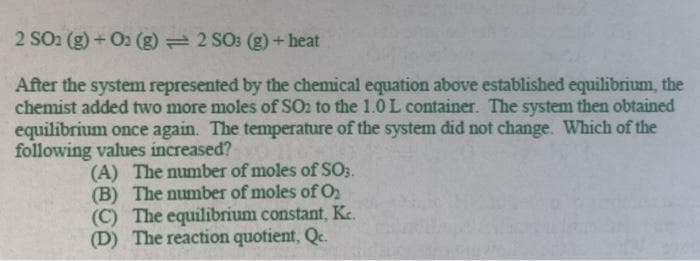2 SO2 (g)+O2 (g)= 2 SO3 (g) + heat After the system represented by the chemical equation above established equilibrium, the chemist added two more moles of SO2 to the 1.0L container. The system then obtained equilibrium once again. The temperature of the system did not change. Which of the following values increased? (A) The number of moles of SO3. (B) The number of moles ofO (C) The equilibrium constant, K. (D) The reaction quotient, Qc.
2 SO2 (g)+O2 (g)= 2 SO3 (g) + heat After the system represented by the chemical equation above established equilibrium, the chemist added two more moles of SO2 to the 1.0L container. The system then obtained equilibrium once again. The temperature of the system did not change. Which of the following values increased? (A) The number of moles of SO3. (B) The number of moles ofO (C) The equilibrium constant, K. (D) The reaction quotient, Qc.
Chemistry by OpenStax (2015-05-04)
1st Edition
ISBN:9781938168390
Author:Klaus Theopold, Richard H Langley, Paul Flowers, William R. Robinson, Mark Blaser
Publisher:Klaus Theopold, Richard H Langley, Paul Flowers, William R. Robinson, Mark Blaser
Chapter13: Fundamental Equilibrium Concepts
Section: Chapter Questions
Problem 12E: Show that the complete chemical equation, the total ionic equation, and the net ionic equation for...
Related questions
Question

Transcribed Image Text:2 SO2 (g) +O2 (g) 2 SO: (g) +heat
After the system represented by the chemical equation above established equilibrium, the
chemist added two more moles of SO2 to the 1.0L container. The system then obtained
equilibrium once again. The temperature of the system did not change. Which of the
following values increased?
(A) The number of moles of SO3.
(B) The number of moles ofO
(C) The equilibrium constant, Kc.
(D) The reaction quotient, Qc.
Expert Solution
This question has been solved!
Explore an expertly crafted, step-by-step solution for a thorough understanding of key concepts.
This is a popular solution!
Trending now
This is a popular solution!
Step by step
Solved in 3 steps

Knowledge Booster
Learn more about
Need a deep-dive on the concept behind this application? Look no further. Learn more about this topic, chemistry and related others by exploring similar questions and additional content below.Recommended textbooks for you

Chemistry by OpenStax (2015-05-04)
Chemistry
ISBN:
9781938168390
Author:
Klaus Theopold, Richard H Langley, Paul Flowers, William R. Robinson, Mark Blaser
Publisher:
OpenStax

Chemistry
Chemistry
ISBN:
9781305957404
Author:
Steven S. Zumdahl, Susan A. Zumdahl, Donald J. DeCoste
Publisher:
Cengage Learning


Chemistry by OpenStax (2015-05-04)
Chemistry
ISBN:
9781938168390
Author:
Klaus Theopold, Richard H Langley, Paul Flowers, William R. Robinson, Mark Blaser
Publisher:
OpenStax

Chemistry
Chemistry
ISBN:
9781305957404
Author:
Steven S. Zumdahl, Susan A. Zumdahl, Donald J. DeCoste
Publisher:
Cengage Learning


Chemistry: An Atoms First Approach
Chemistry
ISBN:
9781305079243
Author:
Steven S. Zumdahl, Susan A. Zumdahl
Publisher:
Cengage Learning

Chemistry: Principles and Reactions
Chemistry
ISBN:
9781305079373
Author:
William L. Masterton, Cecile N. Hurley
Publisher:
Cengage Learning

Chemistry: The Molecular Science
Chemistry
ISBN:
9781285199047
Author:
John W. Moore, Conrad L. Stanitski
Publisher:
Cengage Learning